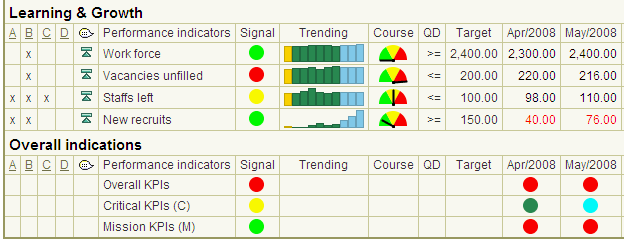|
|
|||
|
| Home | DataMining & Machine Learning | Products & Downloads | Site Map | Contact | |
|||
The Balanced Scorecard (BSC)The Balanced Scorecard (BSC) is a framework for managing business performance. Balanced scorecards provide concise, predictive and actionable information about how a company is performing and may perform in the future. BSC provides a framework for designing a set of measures for business activities as being the key drivers of the business or Key Performance Indicators (KPIs). KPIs are collected from CRM, ERP, Accounting, Personnel, Inventory, and so on. Original versions by Kaplan and Norton consist of four major perspectives: financial, customer, internal process and innovation and learning;
What are the good balanced scorecards?Good balanced scorecards might be said to have good representation on good quality business drivers or KPIs. Qualities of good KPIs include;
KPIs having these attributes alone do not produce good balanced scorecards (BSC). Good BSCs should further posses the following attributes;
Knowledge-Enhanced Predictive Balanced Scorecard improve business visibility!Knowledge-enhanced Predictive Reports (KPRs) can improve business visibility harnessing BSC with predictive modeling and business logic using expert systems. KPRs can analyze changes in business drivers and co-inference them automatically to detect hidden patterns underneath complex numbers. KPRs incorporate predictive modeling with rule-based expert systems into report writing and charting systems;
Incorporation of predictive analytics and rule-based expert systems into BSC provides a number of advantages. First of all, it will make BSC much easier to comprehend potential problems and successes. Trends developing can be detected early so that actions can be followed as early as possible. Complexity in interpreting KPIs is removed in real-time by embedded knowledge of business experts. In addition, governance and compliance rules may be implemented into BSCs, making any potential violations automatically visible to stakeholders. Without complex rule processing engines, this task is almost impossible. Sophisticated predictive models may be employed. The following figure shows a part of a predictive BSC dashboard. "Trending" and "Course" are based on time-series predictive analysis. Signals and figure colors are determined by expert systems which execute business logic. Clearly, this scorecard dashboard meets all the criteria for good balanced scorecards! 
Trending shows recent figures (in seagreen) with near future predictions (in skyblue). (Note that near future figures are predicted using growth models.) Orange bars indicate target figures. "Course" indicates trend patterns. If positive patterns develop, it indicates to green. If negative patterns develop, it indicates to red. If no clear patterns emerge and fluctuations develop, it indicates to yellow for warning. Signals indicate overall health of KPIs. Monthly figures are colored based on pre-defined business rules on target figures. Time-series predictive regression techniques are used in analyzing trends. Rule-based modeling (RME) and RME-EP Expert Systems engines are used to determine status and signals of indicators. For more on predictive balanced scorecard, please write to us! |
|||
|
|
|||
